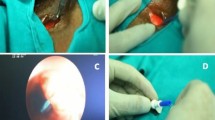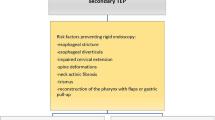Abstract
The objectives of this study were to demonstrate that the length of the tracheoesophageal voice prosthesis changes over time and to determine whether the prosthesis length over time increased, decreased, or showed no predictable change in size. A retrospective chart review was performed at a tertiary care referral center. Patients who underwent either primary or secondary tracheoesophageal puncture between January 2006 and August 2014 were evaluated. Patients were excluded if the tracheoesophageal prosthesis size was not consistently recorded or if they required re-puncturing for an extruded prosthesis. Data analyzed included patient demographics and the length of the tracheoesophageal voice prosthesis at each change. A total of 37 patients were identified. The mean age was 64 years. Seventy-six percent were male. 24 % underwent primary tracheoesophageal puncture and 76 % underwent secondary tracheoesophageal puncture. The length of the prosthesis decreased over time (median Kendall correlation coefficient = −0.60; mean = −0.44) and this correlation between length and time was significant (p = 0.00085). Therefore, in conclusion, tracheoesophageal prosthesis length is not constant over time. The tracheoesophageal wall thins, necessitating placement of shorter prostheses over time. Patients with a tracheoesophageal voice prosthesis will require long-term follow-up and repeat sizing of their prosthesis. Successful tracheoesophageal voicing will require periodic reevaluation of these devices, and insurers must, therefore, understand that long-term professional care will be required to manage these patients and their prostheses.



Similar content being viewed by others
References
Izdebski K, Reed CG, Ross JC, Hilsinger RL Jr (1994) Problems with tracheoesophageal fistula voice restoration in totally laryngectomized patients: a review of 95 cases. Arch Otolaryngol Head Neck Surg 120(8):840–845
Lundy DS, Landera MA, Bremekamp J, Weed D (2012) Longitudinal tracheoesophageal puncture size stability. Otolaryngol Head Neck Surg 147(5):885–888
Andrews JC, Mickel RA, Hanson DG, Monahan GP, Ward PH (1987) Major complications following tracheoesophageal puncture for voice rehabilitation. Laryngoscope 97(5):562–567
Wang RC, Bui T, Sauris E, Ditkoff M, Anand V, Klatsky IA (1991) Long-term problems in patients with tracheoesophageal puncture. Arch Otolaryngol Head Neck Surg 117(11):1273–1276
Department of Health and Human Services. Centers for Medicare and Medicaid Services. Change in Claims Filing Jurisdiction for Tracheo-Esophageal Voice Prosthesis Healthcare Common Procedure Coding System (HCPCS) Code. April 29, 2010. Pub 100-20, CMS Manual System. Washington, DC
Blevins D (2011) IAL Board urges Medicare to change rules on reimbursement of indwelling prosthesis. The International Association of Laryngectomees Newsletter 56(4):1–3
Jebria AB, Henry C, Petit J, Gioux M, Devars F, Traissac L (1987) Physical and aerodynamic features of the Bordeaux voice prosthesis. Artif Organs 11:383–387
Traisssac L et al (2007) Voice rehabilitation after total laryngectomy using the Newvox voice prosthesis. Rev Laryngol Otol Rhinol (Bord) 128:163–172
Leder SB, Sasaki CT (1995) Incidence, timing, and importance of tracheoesophageal prosthesis resizing for successful tracheoesophageal speech production. Laryngoscope 105(8 Pt 1):827–832
Author information
Authors and Affiliations
Corresponding author
Ethics declarations
Conflict of interest
The authors declare that they have no conflict of interest.
Ethical approval
All procedures performed in studies involving human participants were in accordance with the ethical standards of the institutional and/or national research committee and with the 1964 Helsinki declaration and its later amendments or comparable ethical standards. For this type of study formal consent is not required.
Rights and permissions
About this article
Cite this article
Jiang, N., Kearney, A. & Damrose, E.J. Tracheoesophageal fistula length decreases over time. Eur Arch Otorhinolaryngol 273, 1819–1824 (2016). https://doi.org/10.1007/s00405-016-3949-x
Received:
Accepted:
Published:
Issue Date:
DOI: https://doi.org/10.1007/s00405-016-3949-x




